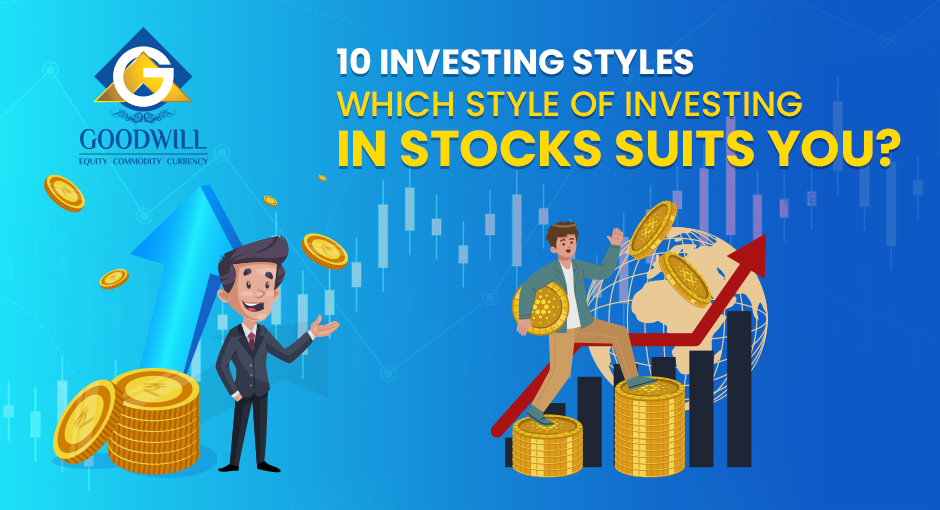
10 Investing Styles – Which style of investing in stocks suits you?
Investing is a lot like marriage. You want to find the right person, and you want to be with that person for a long time. Unfortunately, there’s no such thing as “the perfect stock” or “a winning investment strategy.” Every investor has his or her style of investing, and it’s important to know what your style is before diving into the stock market. There’s no one set-in-stone way of doing things when it comes time to start making money with stocks. Yet, there are certain styles that have proven effective over time.
Thank you for reading this post, don't forget to subscribe!Day trading
Day trading is a form of active investing in which traders buy and sell securities on the same day, aiming to profit from short-term price movements. Day traders use technical analysis and fundamental analysis. They identify stocks that are likely to experience price fluctuations.
Day traders can also use options (the right but not the obligation) or futures contracts for their trading activity.
Blue-chip Investing
Blue-chip investing is the most common type of stock market investment. It involves investing in large, well-established companies that are considered to be safe and sound. These types of companies usually pay dividends. This means they’re able to reinvest earnings back into their businesses and grow further over time.
Examples include: Bajaj, UltraTech, Tata Steel, TCS, and Infosys
Value Investing
Value investing is a great way to invest in stocks. This style of investing seeks out undervalued stocks, which means that they’re trading at a price below what an investor would consider fair value.
There are three main components of value investing:
Low price-to-earnings ratio (P/E) – Investors looking for companies with lower P/E ratios than their peers will find these types of companies more attractive because they tend to be less risky. The higher the P/E ratio, the more likely you are going to lose money on your investment if things don’t work out as planned.
Low price-to-book ratio – The bigger picture here is that low prices mean less risk for investors, which means higher returns over time! It’s worth noting here too though: A low book value could mean nothing more than that there wasn’t much cash available for operations; this doesn’t necessarily mean it’s cheap.
Growth Investing
Growth investing is a long-term investment style that seeks to deliver high returns over time. It’s the opposite of value investing, which seeks to find companies with low share prices and buy them when they’re undervalued. Growth investors look for companies with growing revenue and earnings. As well as those that pay out dividends or cash flow from operations rather than just earnings also known as EBITDA (earnings before interest, taxes, depreciation, and amortization)
Growth investors also tend to favour companies that have high dividend payout ratios and low payout ratios. The former is how much money you get back from your investments per rupee spent. The latter is how much money goes out versus what comes in from sales or other sources like interest payments on debt or loans used by the company itself (like mortgages).
Dividend Investing
Dividend investing is a style of investing in stocks that focuses on companies that pay dividends. Dividend investing can help you achieve your financial goals with a steady stream of income.
Dividendis a share of earnings from a company’s profits. This means they are not taxed as capital gains until they’re paid out to shareholders.
Compounding Interest Investing
Compounding interest is the interest that accumulates on the initial principal amount invested. It’s often referred to as “interest on interest” because it can dramatically increase the value of an investment over time. The key here is that compounding occurs automatically, without any additional work from you—it just happens!
Compounded returns are especially important for investors who have large amounts of money at risk and need their portfolios to grow quickly to fund long-term goals like retirement or college tuition costs (or even just a new car!).
Green Tech Investing
Green tech investing is the use of renewable and non-renewable sources to provide energy for transportation, electricity generation, and other uses. The green economy has grown rapidly over the past decade as awareness about its benefits increases.
Green tech investments can be profitable because they offer growth opportunities in areas with little competition or excess capacity (for example, wind energy). Green technology companies also tend to have lower costs than traditional competitors; therefore you get more bang for your buck when you invest in them.
Trend/Technical Analysis Investing
This investing style is based on the study of trends, charts, and patterns. Technical indicators such as moving averages, Bollinger Bands, and RSI can be used to identify market trends. Fundamental analysis confirms these trends by looking at the fundamentals of a particular company or industry.
Trends in the market are not individual stocks but rather broad markets that have been trading within certain price ranges for some time (a trend). The key thing here is whether you believe this trend will continue or reverse itself over time; if so, then you’ll want to make sure your portfolio has exposure to it before it reverses course completely.
Sector Investing
Sector investing is a way to invest in a specific industry or group of companies. It’s different from sector rotation, which is when you buy and sell shares in your portfolio based on the direction of the overall market.
For example, if you wanted to buy stocks related to technology companies (such as TCS or Infosys), then sector investing would be an ideal option for you because it allows you to focus on one industry rather than spreading yourself too thin by owning multiple stocks within different industries at once.
Active vs Passive Investing
Active investing is when you make your own decisions to buy and sell stocks. You can do this by choosing which companies to invest in, as well as how much money to put into each position.
Passive investing refers to the process of buying a portfolio of stocks that have been designed by an investment manager on behalf of clients. The idea behind passive investing is that it’s easier for investors who don’t have time or expertise with selecting individual investments (also known as “active” investors) because they don’t have control over what goes into their portfolio strategies — instead relying on someone else’s expertise and knowledge base to ensure its success. Passive strategies tend towards lower risk but higher returns than active ones; however, there are no guarantees when it comes to doing things differently from someone else’s ideas!
Conclusion
To sum it all up, there are many ways to invest in stocks, but at the end of the day, it comes down to your goals and preferences. Some people want their money working for them, while others prefer passive investing. Investing is a personal decision that can be tailored according to your own needs. Make sure you’re making informed decisions based on reliable data or authentic expert guidance.
If you are looking to invest while trying to save money, then Goodwill is the place for you. Get the lowest equity brokerage in India with Goodwill, the best equity broker in India. Register today and get Free Trading and Demat Account Opening in less than 10 minutes. Open an account hassle-free and start trading the same day! So why wait? Contact Goodwill today!

